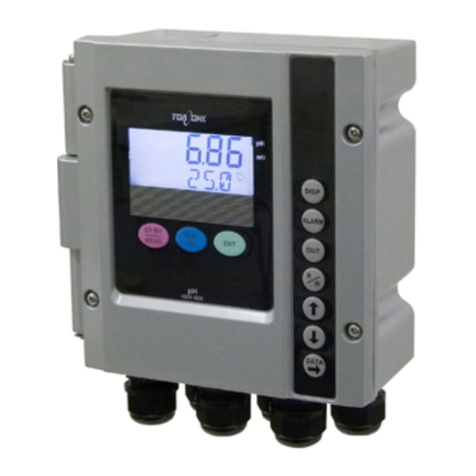
Model WQC-30 Product warranty
-
6
-
Product warranty
(1) Applicable to this warranty
DKK-TOA CORPORATION (hereinafter referred to as “the Company”) guarantees that the product will
operate satisfactorily as in the Company’s prescribed specifications (hereinafter referred to as “the
Specifications”). Failures that occur during the warranty period will be repaired free of charge.
(a) The warranty period of this product is 2 years from the date of delivery. (However, for the case of the
sensor module, it is 1 year from the date of delivery (electrodes etc. are excluded))
(b) Should there be an individually contracted guarantee, then the individual contract will be given
priority.
(c) Where failure or damage not covered by warranty is attributable to the Company, we do not limit the
legal rights regardless of the warranty period.
(2) Exclusions from this warranty
This warranty does not apply to the cases listed below. Repairs will be made for a fee.
(a) Direct or indirect failure or damage etc. caused where the purposes of usage or the usage itself exceed
the ranges specified in the Specifications for the product and its instruction manual.
(b) Direct or indirect failure or damage etc. caused by natural disasters such as earthquakes, wind, flood
and lightning strikes, or by other calamities such as accidents, fires, abnormal voltages, salt damage,
gas hazards, etc.
(c) Failure, damage etc. due to incorrect repair/remodeling attributable to customers.
(d) Failure, damage etc. due to transportation, movement, falls etc. attributable to the customer after
purchase.
(e) Electrodes, sensors, cells and consumables.
(f)
Failure and damage caused by the use of consumables, parts, software, etc. other than those of the
Company.
(g) Failure or damage caused by connected equipment other than that of the Company.
(h) Customer data stored in the product, configuration information, programs or software lost due to
customer responsibility.
(i)
Based on contract specifications etc. with customers, and with regard to the guarantee of products of
other companies specified by customers, which have been used in combination with the products of
the Company (including products embedded to products of the Company), the Company guarantees
only the products of the Company, and the products of other companies are guaranteed by those
companies (*1).
(j) Failure or damage caused by non-fulfillment of maintenance items beyond the maintenance period
specified in the Company’s instruction manual.
(k) Use outside Japan (individual contract is required for use outside Japan).
(l) Product not having a product nameplate (unless there is evidence of delivery by the Company).
(3) Other terms
(a) This warranty is valid only in Japan.
(b) The normal supply period of maintenance parts (*2) to customers with the product is 5 years (*3)
after discontinuation of manufacturing and sales.
(c) An engineer from the Company will judge the cause of failure, damage, etc.
(d) For repairs, please contact our sales representative.
*1: We ask that customers take responsibility for managing the warranties of products made by other
companies.
*2: Maintenance parts are supplementary items necessary to maintain product operation.
*3: When procurement is impossible and there is no alternative item, this may be less than 5 years.
P30 <1>




























